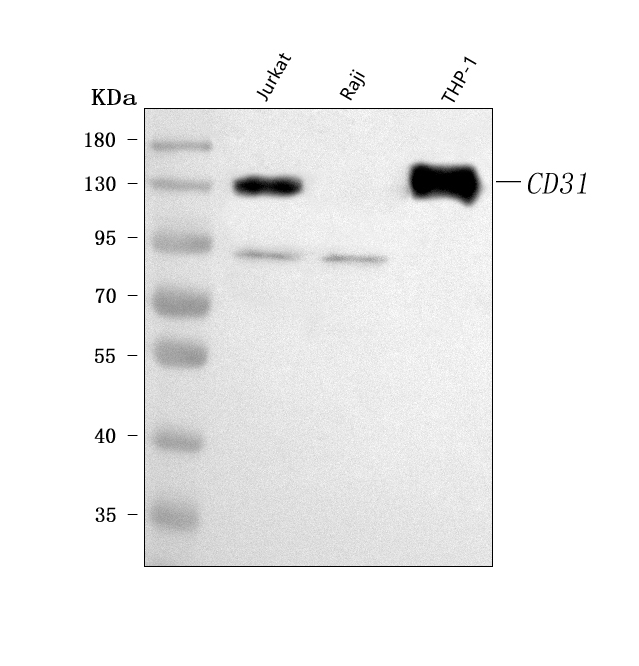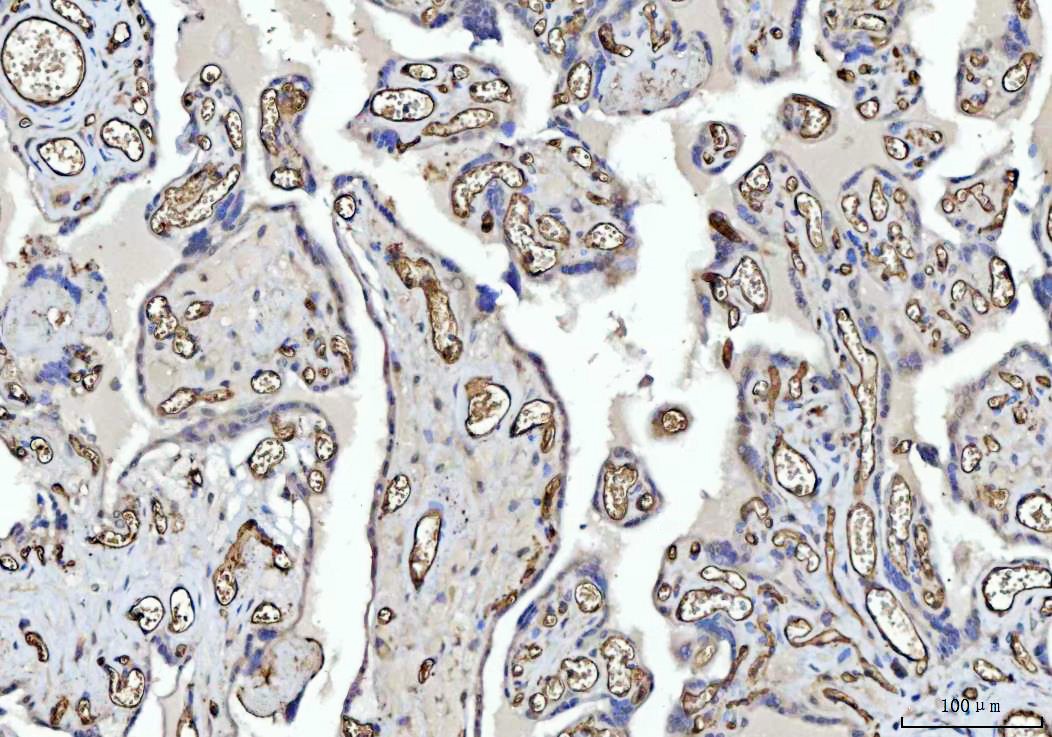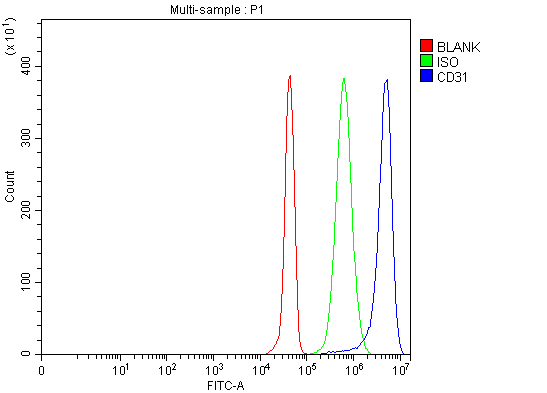| Western blot (WB): | 1:500-2000 |
| Immunohistochemistry (IHC): | 1:50-400 |
| Flow Cytometry (Fixed): | 1:50-200 |
| (Boiling the paraffin sections in 10mM citrate buffer,pH6.0,or PH8.0 EDTA repair liquid for 20 mins is required for the staining of formalin/paraffin sections.) Optimal working dilutions must be determined by end user. | |

Figure 1. Western blot analysis of anti-PECAM-1/CD31 antibody (PB9094). The sample well of each lane was loaded with 30 ug of sample under reducing conditions.
Lane 1: human Jurkat whole cell lysates,
Lane 2: human Raji whole cell lysates,
Lane 3: human THP-1 whole cell lysates.
After electrophoresis, proteins were transferred to a membrane. Then the membrane was incubated with rabbit anti-PECAM-1/CD31 antigen affinity purified polyclonal antibody (PB9094) and probed with a goat anti-rabbit IgG-HRP secondary antibody (Catalog # BA1054). The signal is developed using ECL Plus Western Blotting Substrate (Catalog # AR1197). A specific band was detected for PECAM-1/CD31 at approximately 90 kDa, 130 kDa. The expected band size for PECAM-1/CD31 is at 83 kDa.

Figure 2. IHC analysis of PECAM-1/CD31 using anti-PECAM-1/CD31 antibody (PB9094).
PECAM-1/CD31 was detected in a paraffin-embedded section of human hepatocellular carcinoma tissue. The tissue section was developed using HRP Conjugated Rabbit IgG Super Vision Assay Kit (Catalog # SV0002) with DAB (Catalog # AR1022) as the chromogen.

Figure 3. IHC analysis of PECAM-1/CD31 using anti-PECAM-1/CD31 antibody (PB9094).
PECAM-1/CD31 was detected in a paraffin-embedded section of human placenta tissue. The tissue section was developed using HRP Conjugated Rabbit IgG Super Vision Assay Kit (Catalog # SV0002) with DAB (Catalog # AR1022) as the chromogen.

Figure 4. Flow Cytometry analysis of Jurkat cells using anti-PECAM-1/CD31 antibody (PB9094).
Overlay histogram showing Jurkat cells stained with PB9094 (Blue line). The cells were fixed with 4% paraformaldehyde and blocked with 10% normal goat serum. And then incubated with rabbit anti-PECAM-1/CD31 Antibody (PB9094, 1:100). DyLight®488 conjugated goat anti-rabbit IgG (BA1127, 1:100) was used as secondary antibody. Isotype control antibody (Green line) was rabbit IgG (Catalog # BA1045) (1:100) used under the same conditions. Unlabelled sample (Red line) was also used as a control.

Figure 1. Western blot analysis of anti-PECAM-1/CD31 antibody (PB9094). The sample well of each lane was loaded with 30 ug of sample under reducing conditions.
Lane 1: human Jurkat whole cell lysates,
Lane 2: human Raji whole cell lysates,
Lane 3: human THP-1 whole cell lysates.
After electrophoresis, proteins were transferred to a membrane. Then the membrane was incubated with rabbit anti-PECAM-1/CD31 antigen affinity purified polyclonal antibody (PB9094) and probed with a goat anti-rabbit IgG-HRP secondary antibody (Catalog # BA1054). The signal is developed using ECL Plus Western Blotting Substrate (Catalog # AR1197). A specific band was detected for PECAM-1/CD31 at approximately 90 kDa, 130 kDa. The expected band size for PECAM-1/CD31 is at 83 kDa.

Figure 2. IHC analysis of PECAM-1/CD31 using anti-PECAM-1/CD31 antibody (PB9094).
PECAM-1/CD31 was detected in a paraffin-embedded section of human hepatocellular carcinoma tissue. The tissue section was developed using HRP Conjugated Rabbit IgG Super Vision Assay Kit (Catalog # SV0002) with DAB (Catalog # AR1022) as the chromogen.

Figure 3. IHC analysis of PECAM-1/CD31 using anti-PECAM-1/CD31 antibody (PB9094).
PECAM-1/CD31 was detected in a paraffin-embedded section of human placenta tissue. The tissue section was developed using HRP Conjugated Rabbit IgG Super Vision Assay Kit (Catalog # SV0002) with DAB (Catalog # AR1022) as the chromogen.

Figure 4. Flow Cytometry analysis of Jurkat cells using anti-PECAM-1/CD31 antibody (PB9094).
Overlay histogram showing Jurkat cells stained with PB9094 (Blue line). The cells were fixed with 4% paraformaldehyde and blocked with 10% normal goat serum. And then incubated with rabbit anti-PECAM-1/CD31 Antibody (PB9094, 1:100). DyLight®488 conjugated goat anti-rabbit IgG (BA1127, 1:100) was used as secondary antibody. Isotype control antibody (Green line) was rabbit IgG (Catalog # BA1045) (1:100) used under the same conditions. Unlabelled sample (Red line) was also used as a control.



